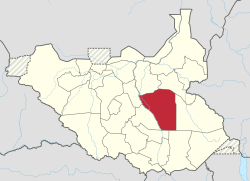Twic East County
Twic East County was a county located in Jonglei State, South Sudan. Its headquarters were located at Panyagor.[1] [note 1] In May 2016, Twic East County was divided into Twic North County, Twic Center County, and Twic South County.[2]
Demographics
Twic East County was composed of five payams: Ajuong, Kongor, Lith, Nyuak, and Pakeer. According to the Fifth Population and Housing Census of Sudan, conducted in April 2008, Twic East County had a combined population of 8,5349 people, composed of 4,4039 male and 4,1310 female residents.[3][note 2]
History
The area encompassed by the former county of Twic East was formerly part of the Bor-Duk District.[4] The Bor-Duk district was later redesignated "Bor County," divided into two in August 2001, and then divided into three counties in 2003: Duk County, Twic East County, and Bor County.[5]
Twic East County was home to the Twic community and named after a founding ancestor named Atwï or Atwïc Ariɛm [Pronounce: Twïny Ariɛm]. According to the Twic origin myth, their ancestors came from Patunduu' or Patundur, which lay to the west of Paliau, where Atwic and his brother, Yiep, lived. They had a falling out, and Atwic left his brother in Patunduu'. After Atwic's departure, Patundur suffered an eight-year drought, which only ended when Yiëu asked his brother to return. When Atwic returned so did the rains, earning him the chieftainship.[6][note 3]
Dr. John Garang a founder of the SPLA and the first Vice President of the Republic of Sudan and the first President of South Sudan was born in Wangulei in Twic East County.[7]
Notable people
- Dr. John Garang de Mabior
- Dr. Majak de Agoot Atem
- Hon. Majok Mading
- Gen. David Barach Manyok
- Dr. Elijah Maluk Lueth
- Hon. Atem Garang D. Dekuek, former Deputy Speaker of Sudan National Assembly 2005-2011
- Prior to the opening of the Twic East County Head Office in July, 2015, the administration of Twic East County was housed in the former office of the Jonglei Canal Project (JCP) in Panyagor. (See Nikkel, Marc (2006). Why Haven't You Left?: Letters from the Sudan. Church Publishing, Inc. p. 119. ISBN 9780898697742.)
- The data collected during the Fifth Population and Housing Census of Sudan were to be the primary source of information for decisions about the number and demarcation of electoral constituencies and administrative boundaries in what was then southern Sudan. South Sudanese officials rejected census results for southern Sudan. See Darfur Relief and Documentation Centre (2010). 5th Population and Housing Census in Sudan – An Incomplete Exercise (PDF) (Report). Darfur Relief and Documentation Centre, Geneva (Switzerland). Archived from the original (PDF) on 18 September 2017. Retrieved 11 June 2017.. Also, see Demographics of South Sudan.
- The names of the communities of Twic were named for the various colors of bulls that were sacrificed to celebrate Atwic's return (for the story, see Simon Harragin (2012). Background Paper for Bor, Twic, Ghol and Nyaraweng Dinka (Report). Jonglei State – Strengthening Conflict Mitigation & Peace-Building – Nairobi Conference 19–21 March 2012. p. 3.
|access-date=requires|url=(help))
References
- Jok, Jacob (July 26, 2015). "Twic East County Head Office Officially Opened In Panyagor". gurtong.net. Bor, South Sudan. Retrieved November 10, 2017.
- "Jonglei state governor names 8 new counties". Sudan Tribune. Bor, South Sudan. May 3, 2016. Retrieved November 10, 2017.
- National Bureau of Statistics (2013). Population Distribution by Sex by Boma, Vol. III (Report). The Republic of South Sudan, The National Bureau of Statistics. pp. 34–35. Archived from the original on 14 November 2017. Retrieved 11 June 2017.
- Johnson, Douglas H. (1982). "Tribal Boundaries and Border Wars: Nuer–Dinka Relations in the Sobat and Zaraf Valleys, c. 1860–1976". The Journal of African History. 23 (2): 183. doi:10.1017/S0021853700020521.
- Simon Harragin (2012). Background Paper for Bor, Twic, Ghol and Nyaraweng Dinka (Report). Jonglei State – Strengthening Conflict Mitigation & Peace-Building – Nairobi Conference 19–21 March 2012. p. 11.
|access-date=requires|url=(help) - Simon Harragin (2012). Background Paper for Bor, Twic, Ghol and Nyaraweng Dinka (Report). Jonglei State – Strengthening Conflict Mitigation & Peace-Building – Nairobi Conference 19–21 March 2012. p. 3.
|access-date=requires|url=(help) - Kuyok, Kuyok Abol (2015). South Sudan: The Notable Firsts. Author House. p. Kindle Location 11752. ISBN 978-1504943444.
